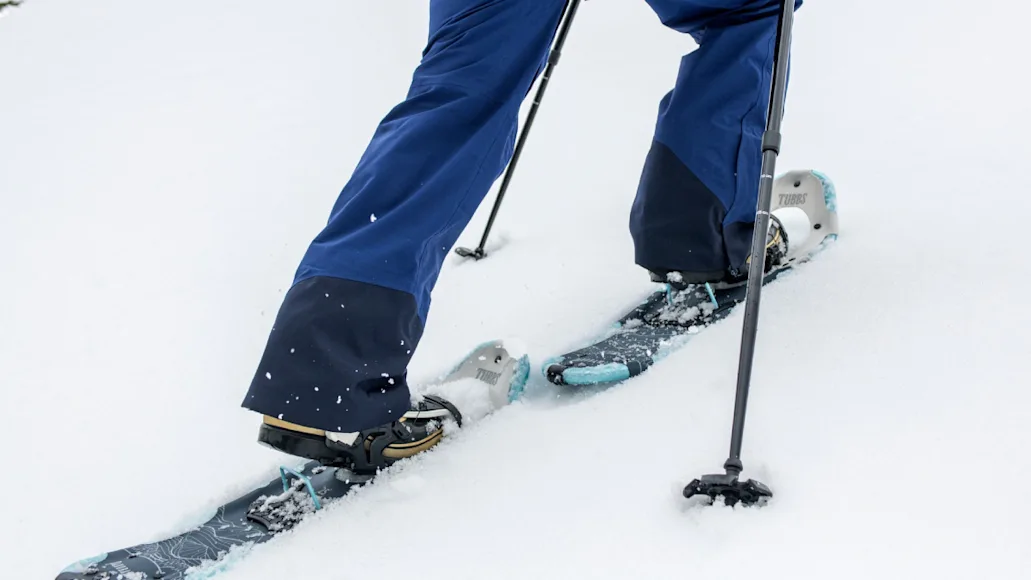_We may earn revenue from the products available on this page and participate in affiliate programs. Learn more ›
_
Best Overall
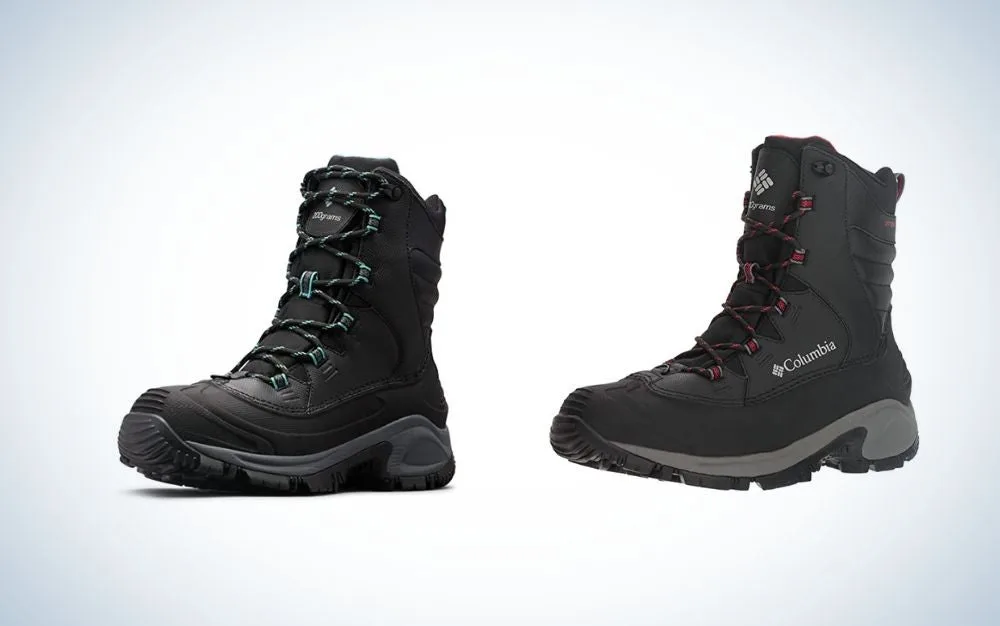
Columbia Bugaboot III Snow Boot
LEARN MORE
Summary
These boots are sturdy enough to comfortably strap into a snowshoe binding, but flexible enough to hike in when the snow is packed.
Best Extra Warm
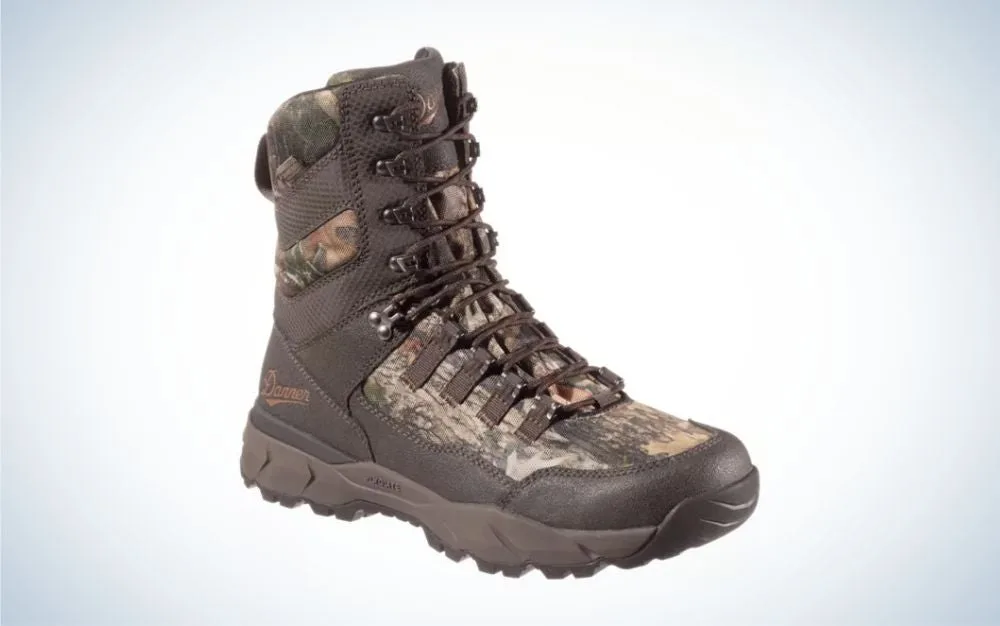
Danner Vital 1200
LEARN MORE
Summary
For snowshoeing adventures in the coldest temperatures, the Danner Vital 1200 will keep feet warm and dry.
Best Women’s
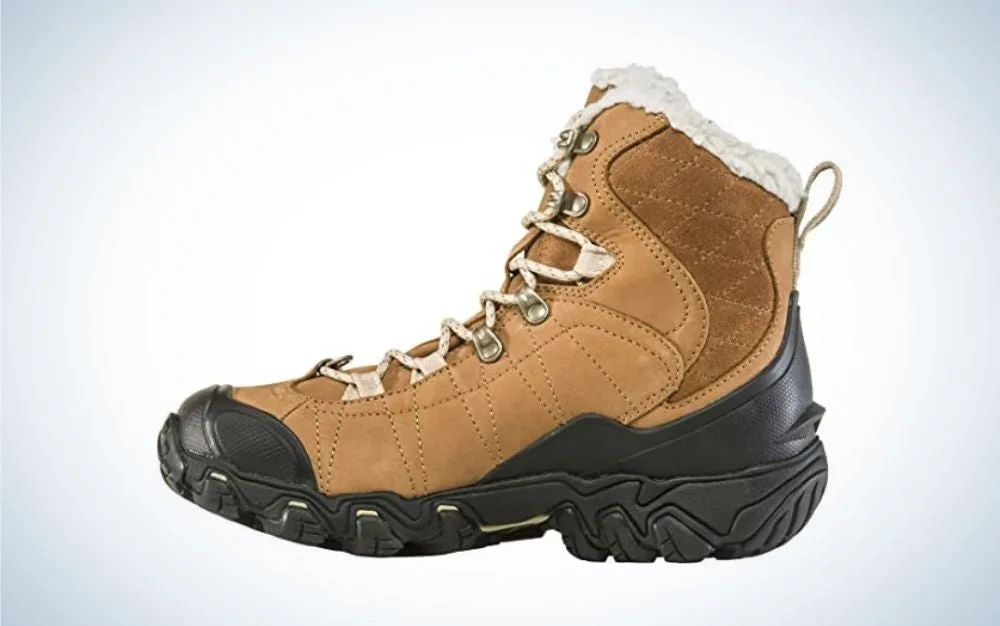
Oboz Bridger 7” Insulated Waterproof Boot
LEARN MORE
Summary
This is a warm, comfortable boot for snowshoeing, winter hiking, or hanging out in town.
Snowshoeing is an ideal way to get outdoors during winter. It’s great exercise, a tool for traveling over deep snow, and is one of the easiest winter sports to adopt. That said, your outdoor adventure will be safer and more fun with the right boots for snowshoeing strapped into your best snowshoes
.
There are tons of options out there for both men and women, whether you want lightweight and well-insulated boots or a pair designed specifically for wide feet. We’ve done all the research to find the best boots for snowshoeing in any condition below.
Best Overall: Columbia Bugaboot III Snow Boot
Best Extra Warm: Danner Vital 1200
Best Budget: Decathlon Quechua SH100 Ultra-Warm Waterproof Hiking Snow Boots
Best for Wide Feet: Keen Revel IV High Polar Boot
Best Lightweight: Vasque Breeze WT GTX
Best Women’s: Oboz Bridger 7” Insulated Waterproof Boot
How We Picked the Best Boots for Snowshoeing
In recent years, winter has become my favorite hiking season. In New Hampshire, winter hiking and adventuring means I’m free from bugs, crowds, and heat. That said, snowshoeing and winter exploring are only possible with the right collection of protective footwear. For this reason, I personally own a collection of multiple winter hiking boots
and snowshoeing boots. Whether I’m walking the dog down a snowy trail, or crossing a winter White Mountain traverse, my winter boots for snowshoeing are going to make or break my trip. For this article, I used the following criteria to determine the best boots for snowshoeing:
Functionality: Winter boots
come in a variety of styles and designs based on the temperatures and winter conditions in which they are intended. I studied the insulation, waterproof capabilities, and design to see if the boots would keep the hiker warm and dry.
Value: Snowshoeing boots aren’t cheap. We want to ensure that every bit of your dollar is going toward a quality purchase. Durability played a big role in deciding if the price of a snowshoe boot made it a good value buy.
Comfort: A winter snowshoeing boot should keep your feet warm and dry. In addition, the user should be able to snowshoe over multiple miles on varied terrain and experience comfortable toes and footbeds. Still, everyone’s feet are different. Sizing and boot shape design play a part in finding the perfect boot for you. But generally speaking, higher quality boots often have more comfortable foot beds and arch support.
Best Boots for Snowshoeing: Reviews and Recommendations
Best Overall: Columbia Bugaboot III Snow Boot
Best Overall

Specs
Material: Waterproof Leather
Insulation: 200 g
Weight Per Boot: 24.5 ounces
Pros
Comfortable
Versatile
Waterproof
Cons
Not for extreme cold
If you are new to snowshoeing and looking for a boot to pair nicely with your snowshoes, the Columbia Bugaboo III Boot is your answer. From the start, the tall heel (18 cm) will keep snow out of the boot and give you support. These boots are sturdy enough to comfortably strap into a snowshoe binding, but flexible enough to hike in when the snow is packed.
With 200 grams of insulation, these can also work as a 3-season hiking boot—keeping feet warm and comfortable in cool fall and spring weather as well. Winter testing proved this boot to keep feet dry over hours of wet winter hiking and snowshoeing. If you are planning to snowshoe in temperatures less than 30℉ or your activity requires long periods of being still, opt for a snowshoeing boot with more insulation.
The Bugaboo III is also an affordable pick for snowshoeing, with MSRP hovering around $100.
Best Extra Warm: Danner Vital 1200
Best Extra Warm

Specs
Material: Waterproof Leather
Insulation: 1200 g
Weight Per Boot: 27 ounces
Pros
Extremely warm
Durable
Comfortable
Cons
Heavy
If your snowshoe trek involves long periods of time sitting still, these are the boots for you. Ice fishing, hunting, and winter camping enthusiasts will appreciate the intense 1200 g of Thinsulate insulation. In addition, the waterproof leather blocks out moisture. The high (8 inch) ankle acts as a barrier to snow while still being versatile enough to hike.
Testers reported this boot to be comfortable out of the box, with little time needed to break them in. The fit is good for those who desire a slightly larger toe box—especially useful for thick winter socks.
The high level of insulation makes this a perfect winter boot, but not transferable to other hiking, fishing, and hunting seasons. For the same boot with less insulation, check out the Danner Vital 400 g
or 800 g
. What’s more, if you love the Danner fit and want a lighter, less insulative boot, opt for the Danner Arctic Side Zip
on Amazon with 200 g of insulation and an easy-to-access zipper entry.
If your snowshoe adventure is going to involve more extreme cold standing than moving, the Baffin Impact
is also a great choice for extra warmth, but lacks the breathability and comfort while walking on the Danner Vital.
Best Budget: Decathlon Quechua SH100 Ultra-Warm Waterproof Hiking Snow Boots
Best Budget
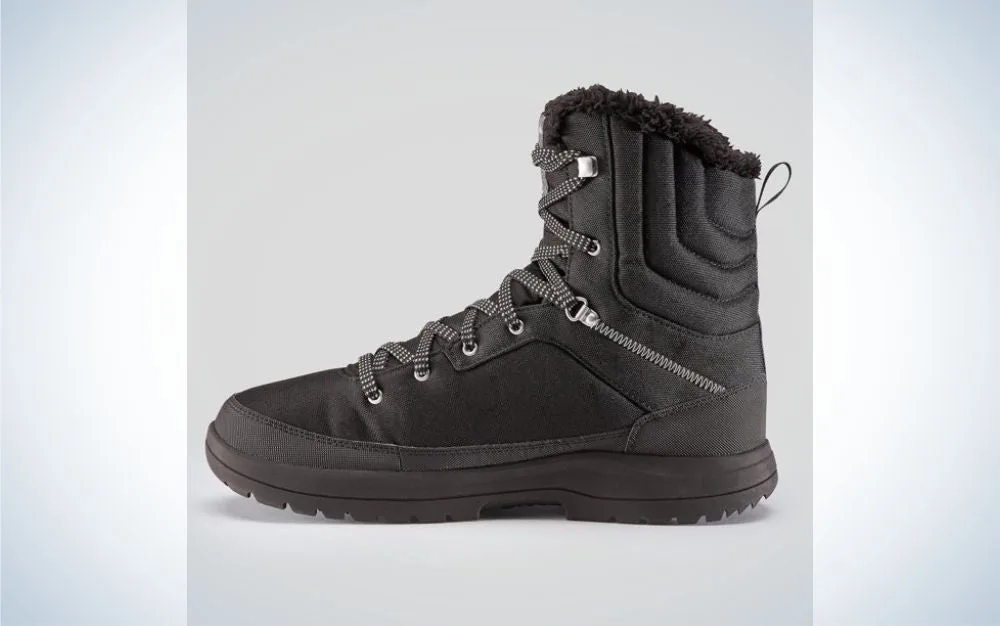
Specs
Material: Waterproof Polyester
Insulation: Data not available. Rated to 12℉
Weight Per Boot: 19.2 ounces
Pros
Comfortable
Lightweight
Affordable
Cons
Long term durability
A high top, waterproof boot under $50 makes the Decathalon Quechua SH100 U-Warm the best budget snowshoeing boot. There’s a lot to like about this boot. Waterproof, insulated, and a durable sole, this is a great choice for those who don’t spend much time in the snow, or are looking for an entry level snowshoeing boot.
This boot is comfortable. The high, flexible ankle keeps snow out while providing comfort while walking and snowshoeing. The exterior is a polyester that over time, will not be as durable as some of its leather competitors. However, parents will likely appreciate this choice for growing kids since snow boots are often only needed for one season.
Decathlon does not report the grams of insulation in their boots. However, they report this boot to be comfortable down to 12℉ if static and -4℉ if moving. Overall, it’s a great budget option.
Best for Wide Feet: Keen Revel IV High Polar Boot
Best for Wide Feet
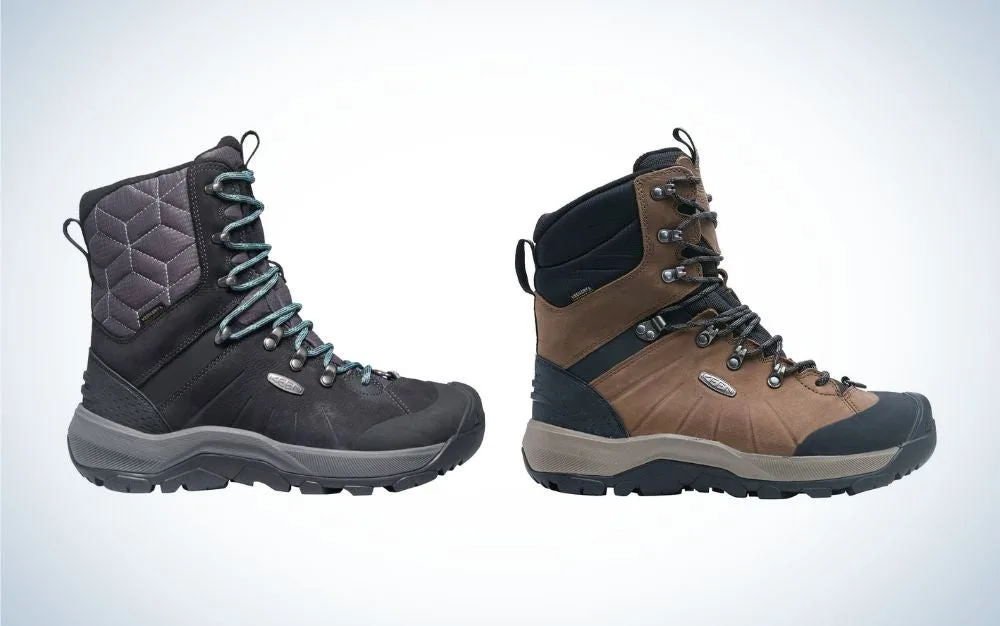
Specs
Material: Waterproof Leather
Insulation: 400 g
Weight Per Boot: 28 ounces
Pros
Comfortable
Great Traction
Durable
Cons
Pricy
The Keen Revel IV High Polar Boots are the best snowshoeing boots for wide feet. The wide toe box is perfect for a wide foot or those who like to wear thick warm socks
. More importantly, they’re comfortable. The compression-molded EVA midsole provides excellent cushioning.
With 400 grams of insulation, this is a one-season boot. Winter recreationalists will love the excellent traction and waterproof breathable membrane. The high ankle provides support that keeps snow out of the booth and ankles warm. For a wider foot hiker or someone looking for a little more room in the toe box, these Keen snow boots are your best bet.
Best Lightweight: Vasque Breeze WT GTX
Best Lightweight

Specs
Material: Nubuck leather and air mesh uppers
Insulation: 200 g
Weight Per Boot: 23 ounces
Pros
Lightweight
Breathable
Comfortable
Cons
Not for extreme cold
Using a lightweight boot has many advantages: they are often more comfortable, burn fewer calories to hike in, and have better breathability. The Vasque Breeze WT GTX is a lightweight winter hiking and snowshoeing boot that keeps feet warm while giving the benefits of lightweight footwear. With 200 g insulation, the Vasque Breeze can function as a fall through spring, 3-season boot. The Gore-Tex waterproof membrane keeps feet dry and comfortable.
The Vasque Breeze also has a thermoplastic poly shank to provide rigid support when scaling ice and in other challenging conditions. Unlike the Keens, this boot is best for those with narrow feet and looking for a boot that runs on the small size.
Best Women’s: Oboz Bridger 7” Insulated Waterproof Boot
Best Women's

Specs
Material: Waterproof nubuck leather
Insulation: 200 g
Weight Per Boot: 20.5 ounces
Pros
Lightweight
Waterproof
Comfortable
Cons
Not for extreme cold
The Oboz Bridger is perfect for winter hiking and snowshoeing. The waterproof leather and rubber sole is completely waterproof. It has 200 g of insulation which is great for milder winter weather and shoulder seasons.
This boot is extremely comfortable, a high ankle boot with the added feature of wool piling around the ankle. We found this added a layer of comfort on the back of the ankle—especially when hiking or snowshoeing over many miles. It also prevents snow from coming in. The toe box of the Oboz Bridger leans a little narrow which works well for the typical women’s foot size.
Lastly, this boot is very light. Women will not feel like they are clunking around in combat boots. Overall, it feels like a warm and comfy hiking boot perfect for a winter snowshoeing adventure.
What to Consider When Choosing Boots for Snowshoeing
There’s no official “snowshoeing boot” category to look through when buying. This makes it challenging for customers to find the right kind of boot to match their snowshoes. Instead, there’s a whole world of winter boots, and it’s up to you to find the right one for your needs. Here’s what to consider before buying snowshoeing boots.
Support
Winter boots come in two main categories: soft sided boots and winter hiking/hunting boots. Do not get a soft sided boot for snowshoeing. While a great choice for ice fishing or clearing the driveway of snow, soft siding snow boots do not provide the rigidity necessary to clamp into a snowshoe binding. Since most snowshoe strapping systems work by tightly strapping over a boot, choose a rigid winter hiking boot or hunting boot for the correct support.
Insulation
Snowshoeing is a cold weather activity. Keep your feet warm by choosing a boot with adequate insulation. Boot insulation is usually reported by the manufacturer in grams of synthetic insulation. Typical winter hiking boots usually range from 200-600 g with some winter boots going up to 1600 g insulation. Here’s how to choose the best insulation snowshoeing boots:
200 g insulation: Perfect for short winter hikes in 30℉ or warmer
400 g insulation: Adequate for most snowshoeing, and rated for 15℉ to 30℉
600 g insulation: Long and cold hikes or outings with periods of standing and sitting, and rated -5℉ to 10℉
800 g insulation: Necessary for winter backpacking in extreme cold, hunting, or lots of still moments, and rated to -20℉ to -10℉
1000 g and more insulation: Important for the most extreme cold temperatures; Used for winter hiking, backpacking and mountaineering, and rated down to -70℉
Additional Features
Besides having a sturdy boot with adequate insulation, there are a few more features to look for in boots for snowshoeing in order to have a comfortable experience.
Waterproof: It’s important to keep feet dry during winter treks. Make sure boots are Gore-Tex or a similar product. Boots that are treated with DWR should be re-treated yearly in order to keep them 100% waterproof.
Ankle Coverage: While tromping through the snow, moisture and snowflakes will likely enter the boot through the ankle. A high-top boot with full ankle coverage will keep feet dry. If you choose a low-top boot, be sure to pair them with gaiters. You can find our pick for best gaiters for snow here
.
Shank: If the plan is to use your snowshoeing boots for ice climbing and mountaineering, it is necessary to get a snowshoeing boot that has a shank. A shank is a stiff layer on the midsole of the boot that allows the user to attach crampons needed for ice climbing. Most snowshoers do not need this level of structure, as snowshoes can be used with a regular winter hiking boot.
FAQs
Q: How much do boots for snowshoeing cost?
Snowshoeing boots cost ranges from $50 to around $250. Higher quality boots cost more and have added features of leather exterior, quality insulation, reliable tread, and waterproof membranes. Lower priced snowshoeing boots are often made of synthetic leathers and not appropriate for extreme cold.
Q: Can you use regular boots with snowshoes?
While they will fit into a snowshoe binding, even the best hiking boots
will not be able to keep feet warm enough in winter temperatures. For a comfortable trek, pair snowshoes with boots labeled as winter hiking boots or mountaineering boots. In addition, many snow boots are sided and cannot provide the support needed to snowshoe. For example, while the Chaco borealis boot
is a comfortable, warm winter boot, if you use them for snowshoeing, the bindings of a snowshoe will dig into the foot.
Q: What are the best kinds of boots for snowshoeing?
The best kind of boots for snowshoeing are waterproof, insulated, and sturdy boots. A soft sided or quilted snow boot will not provide the stability and support needed to latch on a snowshoe. Instead, look for boots in a winter hiking or winter hunting boot category. These boots are often leather, hard soled, and have ankle support.
Q: Are Bean boots good for snowshoeing?
The traditional LL Bean duck boots are not good for snowshoeing. It really comes down to their structure. Bean boots are not insulated and do not have the firm structure needed to keep your ankle steady and snowshoe bindings tight. That said, LL Bean does make a line of winter hiking boots. The Maine Warden Hunting Boot
is a durable, insulative, high top structured boot with 200 g of insulation and a viable option for winter snowshoeing and other activities.l
Best Boots for Snowshoeing: Final Thoughts
Best Overall: Columbia Bugaboot III Snow Boot
Best Extra Warm: Danner Vital 1200
Best Budget: Decathlon Quechua SH100 Ultra-Warm Waterproof Hiking Snow Boots
Best for Wide Feet: Keen Revel IV High Polar Boot
Best Lightweight: Vasque Breeze WT GTX
Best Women’s: Oboz Bridger 7” Insulated Waterproof Boot
Whether you’re new to snowshoeing or looking to upgrade for a more serious winter adventure, the best snowshoe boots are comfortable, waterproof, insulated, and durable. Before purchasing, consider everything that might affect what you need from your boot: the type of winter socks you plan to wear, the temperatures you’re likely to encounter, whether or not you’ll use crampons, etc. Snowshoeing is great to fend off that winter cabin fever, and even better if you hate bugs or crowded trails. That said, your gear becomes even more important when you’re facing those harsh winter conditions. Take your time, consider your options, and you’ll be in a much more comfortable position come winter.
Why Trust Us
For more than 125 years, Field & Stream has been providing readers with honest and authentic coverage of outdoor gear. Our writers and editors eat, sleep, and breathe the outdoors, and that passion comes through in our product reviews. You can count on F&S to keep you up to date on the best new gear. And when we write about a product—whether it’s a bass lure or a backpack—we cover the good and the bad, so you know exactly what to expect before you decide to make a purchase.

